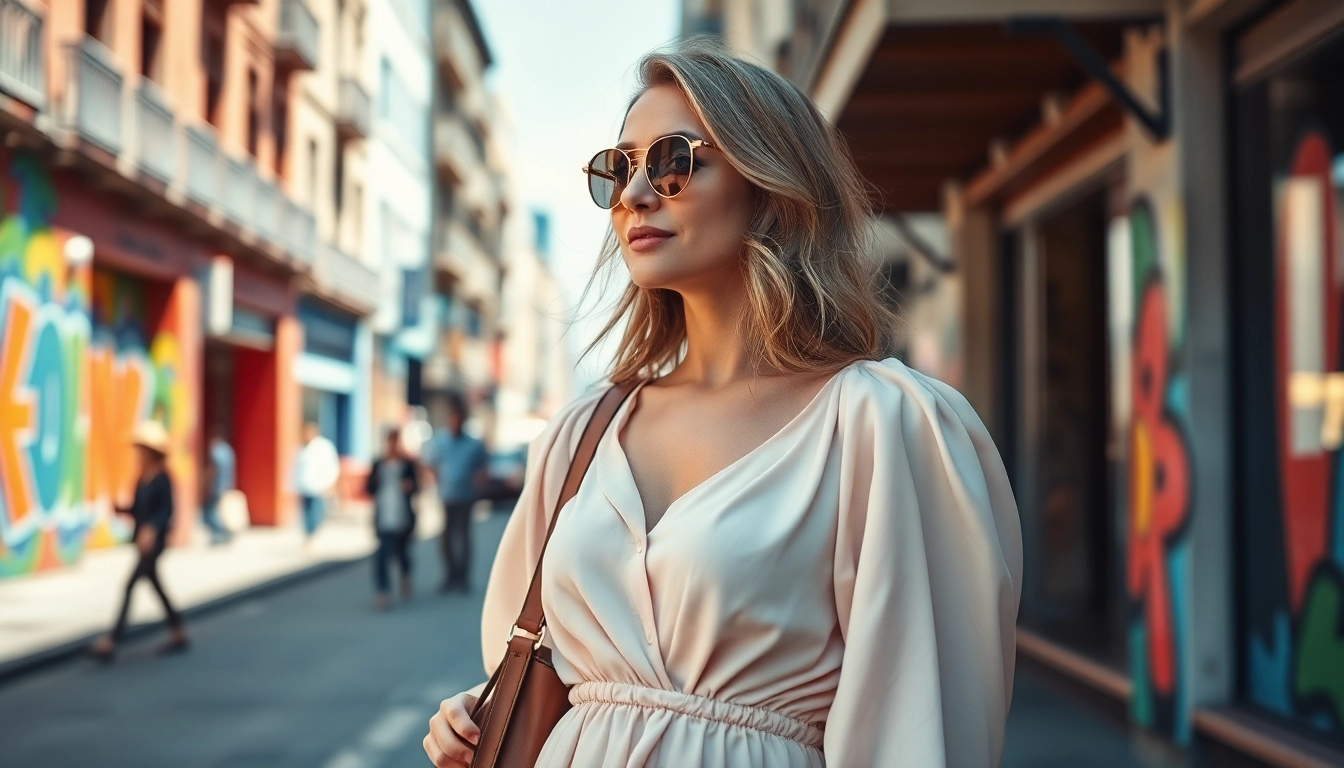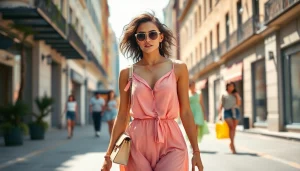Discover Women Fashion: The Ultimate Guide to 2025 Trends

Understanding Women Fashion: Trends and Styles
What is Women Fashion?
Women fashion encompasses a broad spectrum of styles, trends, and identities, each of which reflects societal changes and personal expression. It includes clothing, shoes, accessories, and hairstyles that shape a woman’s public persona and contribute to her self-image. The realm of women fashion ranges from haute couture to casual wear, encompassing everything from elegant dresses for formal occasions to comfortable athleisure. Access to a diverse array of fashionable items enables women to curate their wardrobes based on personal preference, cultural background, and lifestyle needs. The importance of Women Fashion lies in its ability to empower women to express their individuality through clothing choices.
Historical Overview of Women Fashion Trends
The history of women fashion is a rich tapestry woven through time, showcasing significant changes that reflect broader cultural and societal transformations. From the corseted gowns of the Victorian era that emphasized modesty and femininity to the flapper dresses of the 1920s that celebrated liberation and rebellion, women’s fashion has continuously evolved. Each decade has introduced iconic trends—such as the bold silhouettes and colors of the ’80s power suits or the casual grunge looks of the ’90s—marking shifts in women’s roles within society.
In the early 2000s, fashion began to embrace a more eclectic, individualistic approach with the rise of fast fashion, allowing women immediate access to the latest styles. The rise of social media platforms has further accelerated the speed of trends, enabling real-time sharing of fashion ideas and influencing collective styles. Today, sustainability has become a significant concern, pushing brands to reconsider their practices and incorporate eco-friendly materials into their clothing lines.
Current Styles Dominating the Women Fashion Market
As we move into 2025, current styles in women fashion are characterized by a blend of comfort, sustainability, and bold artistry. Items such as oversized blazers, tailored trousers, and relaxed-fit jeans are becoming staples in many wardrobes. Additionally, the ‘athleisure’ trend continues to dominate, promoting the idea that comfort can coexist with style. Streetwear influences can be seen prominently, introducing elements of urban aesthetics into everyday attire.
Moreover, 2025 is seeing a rise in slow fashion brands committed to ethical production methods and sustainable materials. This shift toward conscious consumerism is reshaping the retail landscape, significantly influencing what is fashionable. Major brands and emerging designers are prioritizing eco-friendly practices, offering unique collections that appeal to environmentally-conscious shoppers.
Key Elements of Women Fashion
Essential Clothing Items for Your Wardrobe
A well-curated women’s wardrobe is the foundation for every stylish ensemble. Essential items include:
- Little Black Dress: A versatile staple that can be dressed up or down for various occasions.
- Tailored Blazer: Adds sophistication to casual outfits and can be paired with jeans or a skirt.
- Classic White Shirt: A timeless piece suitable for both professional and casual settings.
- High-Quality Denim: An essential for casual wear, providing comfort without sacrificing style.
- Chic Sneakers: Blending comfort with street style, perfect for various outings.
These items lay the groundwork for mixing and matching, allowing women to create numerous outfits that reflect their style and confidence. The focus on transitional pieces means that women can navigate between different settings, from office wear to weekend casual, seamlessly.
The Importance of Accessories in Women Fashion
Accessories play a crucial role in defining personal style, adding flair and individuality to outfits. Essential accessories include:
- Handbags: A statement bag can elevate even the simplest outfits and is often seen as a fashion statement.
- Jewelry: From minimalist pieces to bold statement jewelry, the right accessories can convey personal stories and styles.
- Sunglasses: Offering both practical benefits and style, they complete many looks while providing protection from the sun.
- Scarves: Versatile and functional, they can be worn in various ways, adding color and texture to outfits.
- Footwear: The choice of shoes can dramatically influence the overall vibe of an outfit, from elegant heels to comfy flats.
Effective accessorizing can transform an outfit from ordinary to extraordinary, allowing women to express their creativity. Moreover, accessories can signify trends, reflecting seasonal styles or personal milestones.
Color Palettes & Fabric Choices for 2025
As fashion evolves, so do the palettes and materials that define it. Recent trend forecasts suggest that 2025 will see a shift towards earthy tones and muted colors, reflecting a growing appreciation for nature and mindfulness.
Key colors to look out for include:
- Earthy Greens: Symbolizing growth and renewal, these tones will underpin many collections.
- Terracotta: Warm and inviting, this color speaks to the rustic charm that many are embracing.
- Soft Whites and Creams: Timeless tones that always symbolize elegance and simplicity.
In terms of fabrics, sustainability will dominate, with increased use of organic materials like cotton and bamboo. Recycled polyester blends and even innovative fabrics made from waste materials will become increasingly commonplace, as brands commit to environmentally conscious practices.
Building Your Women Fashion Brand
Identifying Your Target Audience
Successful fashion brands begin with a clear understanding of their target audience. Brands must engage in thorough market research to identify the demographics, preferences, and lifestyle choices of their intended consumers. Factors such as age, income level, geographic location, and even social media usage play into what products would resonate with potential customers.
Engaging directly with audiences through surveys, focus groups, and social media interactions allows brands to gather valuable insights into customer desires and pain points. This understanding feeds into product development, marketing, and overall brand positioning, allowing for a more personalized approach that fosters brand loyalty.
Creating Unique Selling Propositions in Women Fashion
A distinct unique selling proposition (USP) sets a brand apart from its competitors. In a saturated market, fashion brands must hone in on their identity and value to entice customers. This could be based on quality, sustainability, pricing, or even a niche market focus.
For instance, a brand that focuses on size inclusivity can build a strong message around body positivity, making a community-centered approach part of its core. Innovative designs, such as those incorporating smart textiles or customizable pieces, can also serve as significant USPs, appealing to tech-savvy consumers looking for uniqueness in their wardrobes.
Effective Marketing Strategies for Fashion Brands
To thrive, fashion brands must adopt effective marketing strategies that resonate with their target audience. Digital marketing is paramount, using SEO tactics to enhance online visibility and attract visitors. Engaging content on company blogs and social media platforms captures the audience’s attention and builds a community around the brand.
Collaborations with influencers or fashion bloggers can amplify reach and credibility, especially if the brand aligns with the influencer’s style and values. Additionally, leveraging user-generated content by encouraging customers to share their own styling of the brand’s products creates authentic engagement, showcasing real-life usage and fostering community loyalty.
Overcoming Challenges in Women Fashion Retail
Common Pitfalls in Fashion Buying
Fashion retailers face several pitfalls in buying, from overstocking seasonal items to misreading trend signals. It’s crucial to balance inventory management with demand forecasting. Utilizing data analytics can help retailers anticipate trends, inventory needs, and optimize stock levels, thereby reducing waste and boosting sales.
Additionally, maintaining a flexible supply chain can allow brands to pivot quickly in response to market demands, minimizing the risk of being left with unsold products as trends shift rapidly.
Adapting to E-commerce Trends in Women Fashion
As e-commerce continues to dominate the retail landscape, fashion brands must adapt their strategies for a seamless online shopping experience. Implementing user-friendly website interfaces, hassle-free return policies, and robust mobile capabilities can cater to a growing digital consumer base.
Brands should also explore virtual try-on technology, utilizing augmented reality to allow consumers to visualize how clothing will fit them before purchasing. Such innovations enhance user experience and increase conversion rates, directly impacting sales.
Addressing Sustainability in Fashion Choices
As consumers grow increasingly aware of the environmental impact of their choices, many seek brands that prioritize sustainability. Adopting sustainable practices, from sourcing to production, can help meet this demand and create a loyal customer base. This may involve utilizing biodegradable materials, ensuring fair labor practices, and implementing efficient production processes.
Fashion brands that make sustainability part of their core values not only attract environmentally conscious consumers but also contribute positively to global challenges. Transparency in operations, showcasing efforts toward sustainability, and empowering customers to make informed choices can position a brand as a leader in eco-conscious fashion.
Measuring Success in Women Fashion
Key Performance Indicators for Fashion Brands
To gauge success in the competitive women fashion landscape, brands should monitor essential key performance indicators (KPIs). Metrics to consider include:
- Sales Growth: Tracking revenue changes over time can indicate overall business health.
- Customer Acquisition Cost (CAC): Understanding expenses associated with gaining new customers reveals marketing effectiveness.
- Return Rate: Monitoring how often items are returned helps identify potential issues in sizing or quality.
- Customer Lifetime Value (CLV): Assessing the total revenue a business can expect from a customer throughout their relationship aids in long-term strategy planning.
Regular reviews of these KPIs allow brands to adjust marketing tactics, product offerings, and customer engagement efforts to optimize performance continually.
Engaging Customers through Social Media
Social media engagement plays a pivotal role in fostering customer relationships in the fashion industry. Brands can utilize platforms like Instagram, Pinterest, and TikTok to create visually stunning content that resonates with their audience.
Utilizing storytelling techniques in posts and creating interactive content—such as polls, contests, or live fashion shows—can enhance brand connection. Collaborating with influencers who reflect the brand’s ethos can introduce the brand to wider audiences, enabling authentic engagement through trusted voices.
Trends and Future Predictions for Women Fashion
As we look to the future, trends such as customization and personalization will continue to rise. Brands that offer unique, tailored experiences—such as made-to-measure clothing or personalized styling—will likely thrive. The power of data analytics will help businesses understand customer preferences in-depth, leading to highly personalized shopping experiences.
Moreover, a collective shift towards hybrid shopping experiences combining in-store and online elements will emerge. As the fashion landscape evolves, the incorporation of technology, such as virtual fitting rooms and AI-driven fashion assistants, will offer consumers innovative ways to connect with brands.
In conclusion, women fashion continues to evolve, with trends reflecting societal values, lifestyles, and expectations. The infusion of sustainability, creativity, and technology will shape this dynamic industry, offering endless possibilities for the future.






